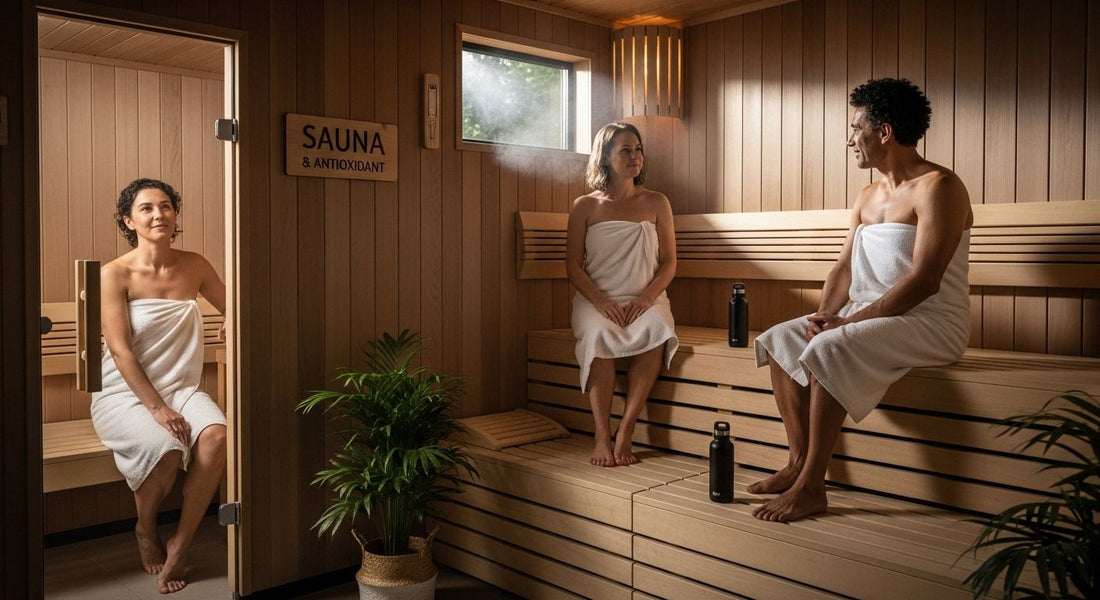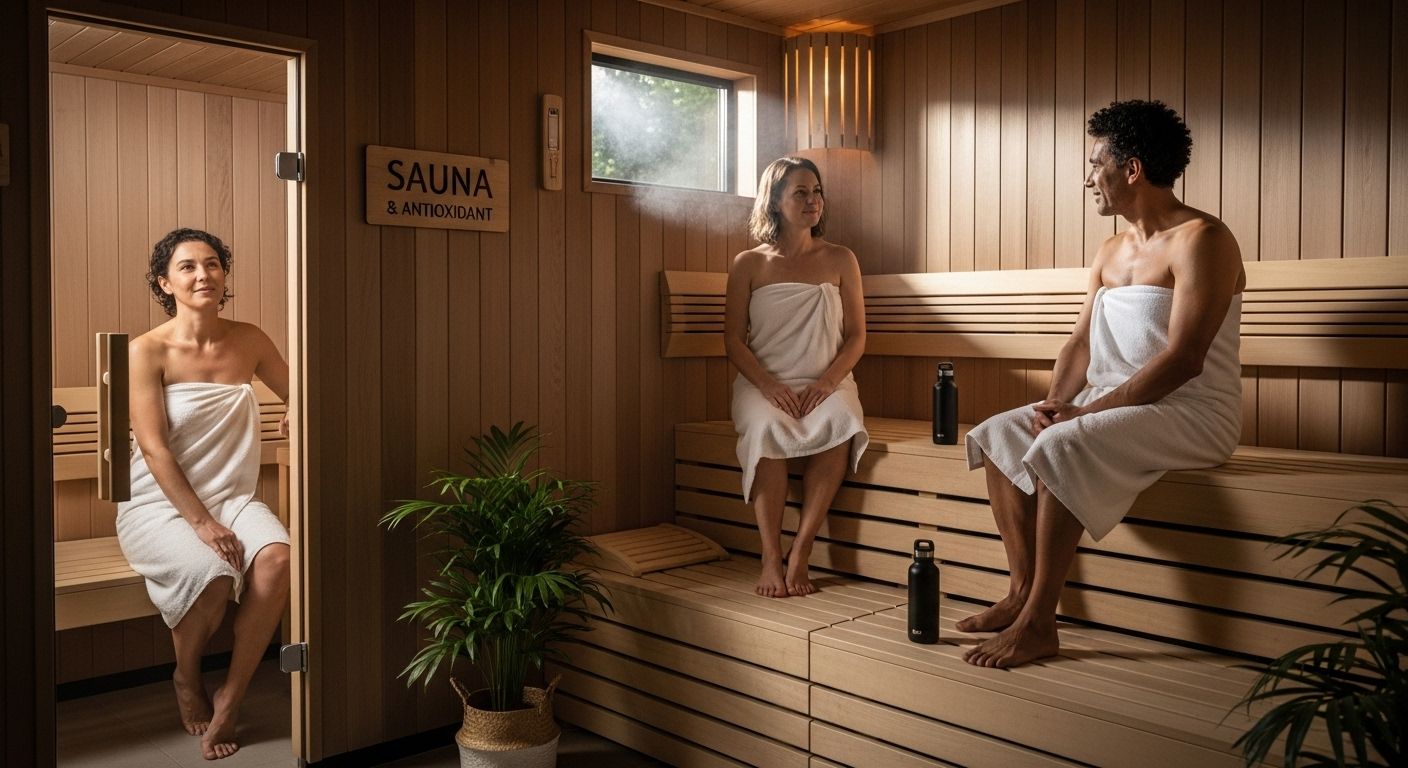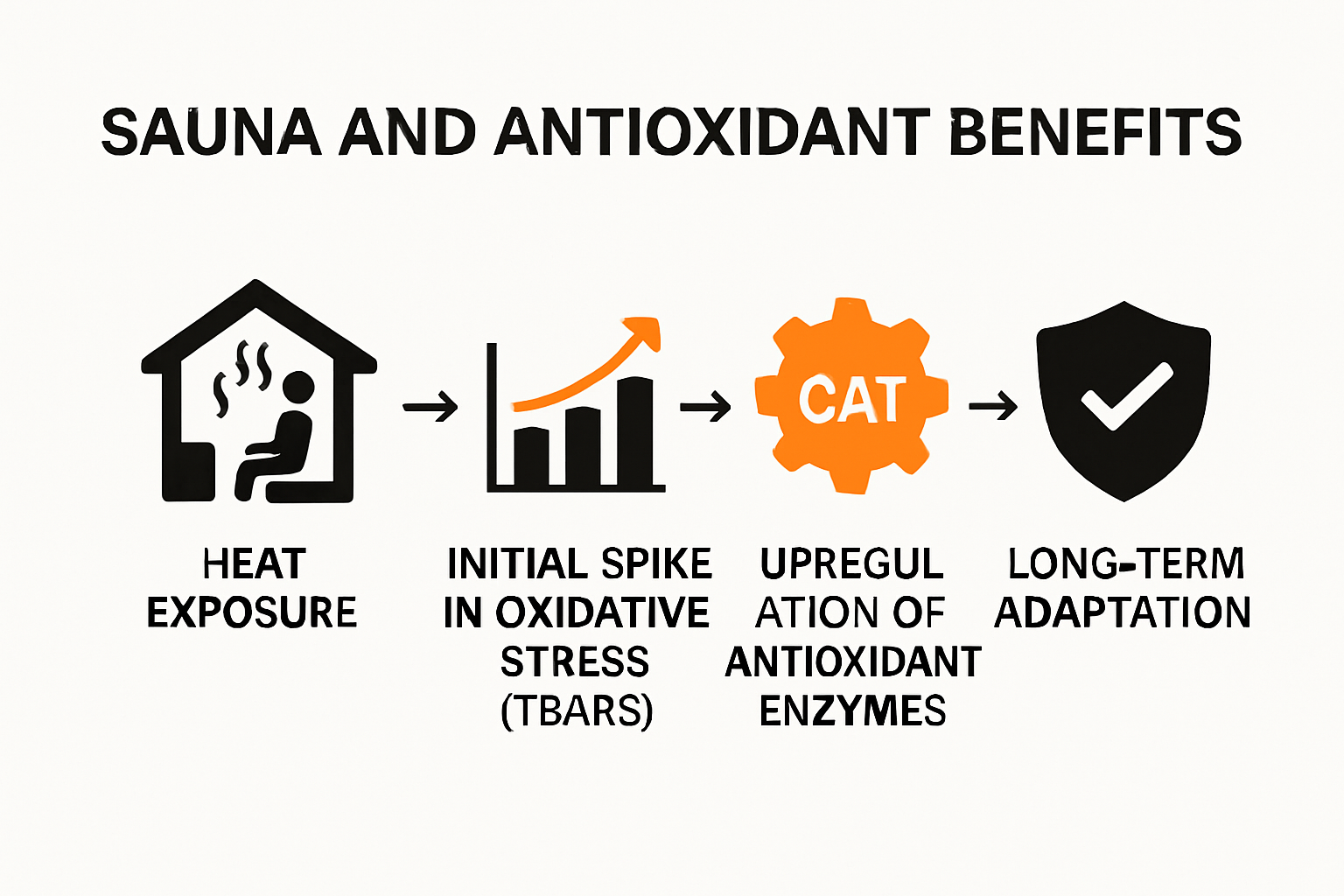
Sauna and Antioxidant Benefits: Boost Wellness and Recovery

Saunas are known for their steamy warmth and relaxing vibes. You may have heard that sweating it out in a sauna makes you feel good, but the science goes way deeper than just relaxation. In fact, studies show that one sauna session can increase your body’s antioxidant enzyme activity by a surprising 8.5%. So if you think a sauna is just for unwinding after a workout, you are missing the real story. The real magic lies in how saunas train your body to defend itself and boost your natural defenses in ways most health routines never touch.
Table of Contents
- How Saunas Influence Antioxidant Levels
- Key Health Benefits Of Sauna Sessions
- Choosing The Right Sauna For Your Home
- Simple Tips To Maximize Sauna And Antioxidant Benefits
Quick Summary
| Takeaway | Explanation |
|---|---|
| Saunas enhance antioxidant defenses. | Regular sauna use stimulates the body’s physiological responses, boosting antioxidant production and improving resilience against oxidative stress. |
| Incorporate sauna into a routine. | Aim for 2-3 sessions per week, lasting 15-20 minutes each to effectively harness sauna’s health benefits. |
| Choose the right sauna type. | Understand the differences between traditional and infrared saunas to select one that fits your health goals and living space. |
| Pair sauna use with an antioxidant-rich diet. | Foods rich in vitamins C and E help neutralize free radicals, enhancing recovery and overall wellness after sauna sessions. |
| Listen to your body’s signals. | Individual responses to heat stress vary; adjust sauna duration and frequency based on personal comfort and health conditions. |
How Saunas Influence Antioxidant Levels
Understanding the intricate relationship between sauna use and antioxidant levels reveals a fascinating physiological response that goes beyond simple relaxation. Saunas trigger a complex cascade of biological mechanisms that challenge and ultimately strengthen the body’s oxidative defense systems.
The Physiological Stress Response and Antioxidant Activation
When exposed to the intense heat of a sauna, the human body experiences a controlled form of physiological stress that initiates remarkable adaptive responses. Research published in the Medical Science Monitor demonstrates that a single sauna session can produce significant changes in oxidative status. The study revealed a 12.7% increase in plasma thiobarbituric acid reactive substances (TBARS) concentration, indicating an initial elevation in oxidative stress.
However, this temporary stress is not a negative outcome. Instead, it serves as a powerful stimulus for the body’s antioxidant defense mechanisms. The catalase (CAT) enzyme activity increased by approximately 8.5% post-sauna, signaling an adaptive antioxidant response. This mechanism is similar to how muscles grow stronger after resistance training - by experiencing controlled stress and subsequent recovery.
Differential Responses in Trained and Untrained Individuals
Interestingly, the body’s response to sauna-induced oxidative stress varies between individuals with different fitness levels. A study in the Journal of Human Kinetics revealed that athletes experience less pronounced oxidative changes compared to untrained individuals. This suggests that regular physical training may enhance the body’s resilience and improve its ability to manage oxidative stress.
The research highlights that while sauna exposure initially triggers an oxidative challenge, the body responds by ramping up its antioxidant production. Trained athletes demonstrated more efficient antioxidant systems, indicating that consistent physical activity and sauna use could potentially improve overall oxidative defense capabilities.
Long-Term Antioxidant System Adaptation
Clinical investigations into infrared sauna sessions provide further insights into the body’s adaptive mechanisms. A study examining volunteers found that repeated high-temperature exposures stimulate complex biological responses. The initial increase in free radical processes is followed by activation of protective antioxidant defenses and restoration of cellular membrane stability.
This adaptive response suggests that regular sauna use might serve as a form of controlled hormetic stress - a mild stressor that ultimately strengthens physiological systems. The body learns to become more resilient, enhancing its ability to neutralize harmful free radicals and maintain cellular integrity.
The implications are profound: sauna sessions are not merely a relaxation technique but a potential strategy for improving the body’s natural antioxidant capabilities. By subjecting ourselves to controlled heat stress, we may be training our internal defense systems to become more robust and efficient at combating oxidative damage.
While more research is needed to fully understand these mechanisms, current evidence suggests that incorporating sauna sessions into a wellness routine could offer significant antioxidant-related benefits. The key lies in consistency, moderation, and listening to one’s body during the process.

Key Health Benefits of Sauna Sessions
Sauna sessions represent far more than a simple relaxation technique. These heat-based wellness experiences offer a comprehensive approach to improving physical and mental health through multiple physiological mechanisms.
Cardiovascular Health and Circulation Enhancement
Research published in PubMed reveals that regular sauna bathing is associated with significant reductions in vascular and nonvascular diseases. The heat exposure triggers profound cardiovascular responses that mimic moderate exercise, creating beneficial adaptations in the body.
During a sauna session, body temperature rises, causing blood vessels to dilate and improve circulation. This process generates responses similar to cardiovascular exercise, promoting better blood flow and potentially reducing blood pressure. The increased heart rate and improved vascular function can contribute to overall cardiovascular resilience.
Immune System and Stress Reduction
Comprehensive research from Mayo Clinic Proceedings highlights the remarkable impact of sauna sessions on immune system function. Heat exposure stimulates the production of heat shock proteins, which play a crucial role in cellular protection and stress response.
The controlled heat stress experienced during sauna bathing activates the body’s natural defense mechanisms. This process can potentially enhance immune cell production and improve the body’s ability to fight infections. Moreover, the intense heat promotes the release of endorphins, which help reduce stress and improve overall mental well-being.
Neurological and Recovery Benefits
Beyond immediate physiological responses, sauna sessions demonstrate promising implications for long-term health. The Mayo Clinic research indicates potential benefits in reducing the risk of neurocognitive diseases. The increased blood circulation and heat-induced stress response may contribute to improved brain function and neuroplasticity.
Athletes and fitness enthusiasts have long recognized saunas as valuable recovery tools. The heat helps relax muscles, reduce inflammation, and accelerate recovery processes. By promoting blood flow and triggering natural healing mechanisms, sauna sessions can support muscle repair and reduce post-exercise soreness.
The multifaceted health benefits of sauna sessions extend far beyond simple relaxation. From cardiovascular improvements to potential neurological protection, these heat therapy experiences offer a holistic approach to wellness. While individual responses may vary, the growing body of scientific research suggests that incorporating regular sauna sessions into a healthy lifestyle could provide substantial health advantages.
As with any wellness practice, moderation and individual health considerations are key. Consulting with healthcare professionals and listening to one’s body remains essential when exploring the potential benefits of sauna therapy.
Choosing the Right Sauna for Your Home
Selecting the ideal sauna for your home involves carefully considering multiple factors beyond aesthetic preferences. The right sauna can transform your wellness routine and provide significant health benefits tailored to your specific needs.
Understanding Sauna Types and Their Unique Characteristics
Research from the National Institutes of Health reveals distinct differences between sauna types that significantly impact their health benefits. Traditional Finnish saunas and modern infrared saunas offer unique experiences and physiological responses.
Traditional Finnish saunas use high temperatures and low humidity, typically ranging between 170-200 degrees Fahrenheit. These saunas create an intense heat environment that induces profound sweating and cardiovascular responses. In contrast, infrared saunas operate at lower temperatures around 110-130 degrees Fahrenheit but penetrate body tissue more deeply, potentially offering more targeted therapeutic benefits.
Practical Considerations for Home Sauna Installation
Guidance from the Mayo Clinic emphasizes the importance of selecting a sauna that matches your specific health goals and home environment. Consider factors such as available space, electrical requirements, and personal health objectives.
Infrared saunas generally require less space and lower electrical capacity compared to traditional Finnish saunas. They can often be installed in smaller areas like bedrooms or home offices. Traditional saunas typically need dedicated spaces with proper ventilation and robust electrical infrastructure. Your home’s layout, budget, and wellness goals should guide your selection process.
To help you choose the best sauna for your needs, here’s a comparison of the main sauna types discussed in the article, highlighting their temperature ranges, heat sources, space requirements, and potential benefits.
| Sauna Type | Temperature Range (°F) | Heat Source | Space Requirement | Key Benefits |
|---|---|---|---|---|
| Traditional Finnish | 170-200 | Heated rocks/electric | Larger, well-ventilated | Intense heat, deep sweating |
| Infrared | 110-130 | Infrared heating panels | Smaller, flexible | Deep tissue penetration, lower temp |
Safety and Maintenance Recommendations
The Centers for Disease Control and Prevention provides critical guidelines for safe sauna operation. Proper ventilation, temperature control, and regular maintenance are essential for creating a safe and effective home wellness environment.
When choosing a sauna, evaluate the construction materials, heating elements, and manufacturer’s safety certifications. Look for models with built-in temperature controls, automatic shut-off features, and materials resistant to moisture and heat degradation. Wood types like cedar and hemlock are popular for their durability and natural resistance to bacteria.
Consider your personal health status when selecting a sauna. Individuals with cardiovascular conditions, pregnant women, or those with chronic health issues should consult healthcare professionals before incorporating sauna sessions into their wellness routine.
The investment in a home sauna extends beyond monetary considerations. It represents a commitment to personal health, stress reduction, and holistic wellness. By carefully evaluating your needs, understanding different sauna technologies, and prioritizing safety, you can select a sauna that becomes a transformative addition to your home wellness strategy.
Remember that the most expensive or technologically advanced sauna is not necessarily the best fit. The ideal sauna is one that aligns with your lifestyle, health goals, and provides a comfortable, rejuvenating experience tailored to your individual needs.
Simple Tips to Maximize Sauna and Antioxidant Benefits
Optimizing sauna sessions and antioxidant benefits requires a strategic approach that combines intentional practices, nutritional support, and mindful recovery. By implementing targeted techniques, individuals can enhance the physiological advantages of heat therapy and support their body’s natural defense mechanisms.
Strategic Sauna Session Planning
Research from a comprehensive 2023 systematic review emphasizes the importance of moderate and consistent sauna bathing to stimulate hormetic stress responses. These controlled stress exposures can activate endogenous antioxidant defense systems, promoting cellular resilience and overall wellness.
To maximize benefits, aim for 2-3 sauna sessions per week, each lasting 15-20 minutes. Beginners should start with shorter durations and gradually increase exposure time. Pay attention to your body’s signals and avoid overexertion. Consistency is more important than intensity when building adaptive physiological responses.
Nutritional Support for Enhanced Recovery
Scientific research indicates that combining sauna sessions with a diet rich in antioxidants can significantly amplify recovery and wellness benefits. Focus on consuming foods high in vitamins C and E, which help neutralize free radicals and support the body’s natural antioxidant mechanisms.
Ideal antioxidant-rich foods to incorporate include:
- Berries: Blueberries, strawberries, and raspberries
- Leafy Greens: Spinach, kale, and Swiss chard
- Nuts and Seeds: Almonds, walnuts, and chia seeds
- Colorful Vegetables: Bell peppers, tomatoes, and sweet potatoes
Hydration plays a crucial role in maximizing sauna benefits. Drink water before, during, and after your sauna session to support metabolic processes and help flush out toxins. Consider electrolyte-rich beverages to replenish minerals lost through sweating.
Below is a summary table of antioxidant-rich foods and hydration methods mentioned in the article that can enhance your recovery after sauna sessions.
| Category | Examples | Benefit |
|---|---|---|
| Berries | Blueberries, strawberries, raspberries | High in vitamin C and antioxidants |
| Leafy Greens | Spinach, kale, Swiss chard | Vitamin E, supports antioxidant defense |
| Nuts & Seeds | Almonds, walnuts, chia seeds | Healthy fats, vitamin E |
| Colorful Veggies | Bell peppers, tomatoes, sweet potatoes | Rich in antioxidants, vitamin C |
| Hydration | Water, electrolyte-rich beverages | Replenishes fluids and minerals |
Recovery and Complementary Practices
Enhance your sauna and antioxidant strategy by incorporating complementary wellness practices. Light stretching or gentle yoga before or after sauna sessions can improve circulation and support muscle recovery. Cold showers or contrast therapy (alternating between hot and cold temperatures) may further stimulate the body’s adaptive responses.
Mindfulness techniques like deep breathing or meditation can help manage the physiological stress induced by sauna heat. These practices not only support mental well-being but can also help regulate the body’s stress response, potentially enhancing the overall therapeutic effect.
It’s essential to listen to your body and adjust your approach based on individual responses. What works for one person may not be ideal for another. Some individuals might require longer recovery times or different nutritional strategies.
Consult with healthcare professionals, especially if you have pre-existing health conditions or are taking medications. They can provide personalized guidance tailored to your specific health profile and wellness goals.
Remember that sauna therapy and antioxidant support are part of a holistic approach to wellness. Combining strategic heat exposure, targeted nutrition, and mindful recovery can help unlock the full potential of these powerful health-enhancing practices.

Frequently Asked Questions
What are the antioxidant benefits of using a sauna?
Regular sauna use can enhance the body’s antioxidant enzyme activity, reducing oxidative stress and improving overall resilience against cellular damage. A single session can boost antioxidant defenses by about 8.5%.
How often should I use a sauna to experience its health benefits?
To effectively harness the health benefits of sauna sessions, aim for 2-3 sessions per week, lasting 15-20 minutes each. Consistency is key in maximizing antioxidant and wellness benefits.
What is the difference between traditional saunas and infrared saunas?
Traditional Finnish saunas operate at higher temperatures (170-200°F) and lower humidity, while infrared saunas work at lower temperatures (110-130°F) but penetrate deeper into body tissues. This results in different health benefits and experiences.
Can sauna sessions enhance recovery after exercise?
Yes, sauna sessions can reduce muscle soreness and promote recovery by increasing blood circulation and reducing inflammation. The heat helps relax muscles and triggers the body’s natural healing processes.
Ready to Transform Your Recovery and Unlock Real Antioxidant Power?
If you have learned that sauna sessions can turbocharge your body’s antioxidant defenses, boost recovery, and help you build resilience against stress, it is time to experience those benefits at home. Many people struggle to find a reliable way to support their immune system, improve circulation, and enhance well-being on a daily basis. With Best Life Sauna, you do not need to settle for just reading about results – you can begin feeling them, too.

Discover our carefully selected range of premium saunas and wellness solutions made for real-life recovery and relaxation. Whether you want a traditional or infrared sauna, or you are interested in adding cold plunges and supportive accessories, we have options that fit your goals. Shop now and get free shipping on wellness orders over $200. Make your antioxidant routine a daily ritual by visiting Best Life Sauna and bring true wellness home today.

